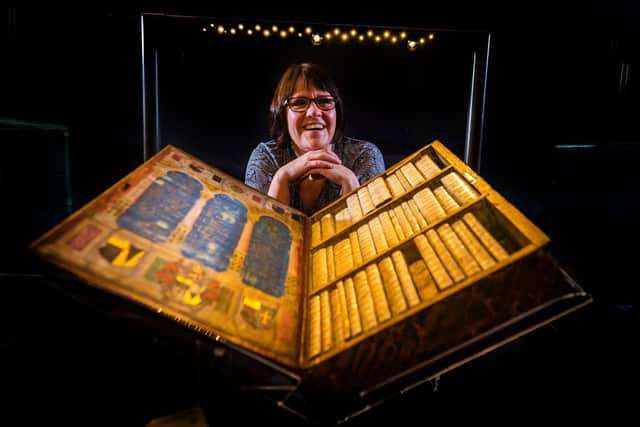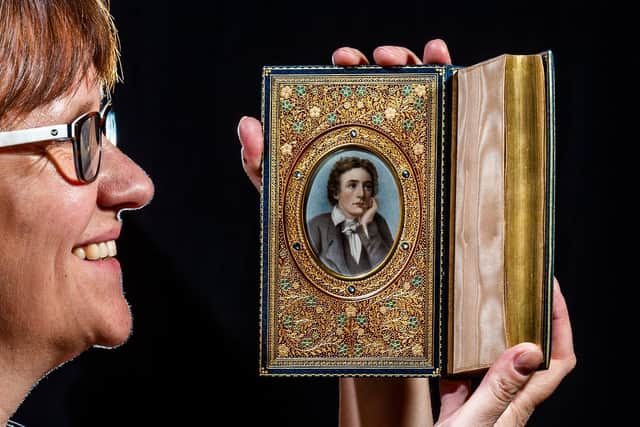How the foundations of Leeds' Brotherton Collection of rare books and manuscripts were laid 100 years ago
It’s been badged as a 1600s version of the Kindle; an easy and portable way of carrying around literature.
For when the cover of the Jacobean travelling library at the University of Leeds is lifted, it is not, as it seems, a rather large book, but instead a collection of 43 miniature volumes, arranged neatly on shelves inside a wooden box.
Advertisement
Hide AdAdvertisement
Hide Ad“It’s one of our audience’s favourites,” says Rhiannon Lawrence-Francis, collections and engagement manager. “It’s been called various things and I suppose you could say it’s the 17th century Kindle.”


One of only four known examples of its kind in the world, the travelling library is among many of the fascinating treasures that are held in the university’s Brotherton Collection.
It has been selected for an exhibition to mark the collection’s centenary, helping to tell the story of how one of the most important and extensive compilations of rare books and manuscripts came into being at the hands of industrialist Edward Allen Brotherton.
Born in Manchester in 1856, Brotherton was a chemical magnate, launching his first business at the age of 22. By the time of his death in 1930, he had created one of the largest chemical manufacturing empires of his time.


Advertisement
Hide AdAdvertisement
Hide AdThe first of his factories was established in Wakefield and he had a fond connection with the city. As well as serving a period as the Mayor of Wakefield – and another as Lord Mayor of Leeds – he became MP for Wakefield on two separate occasions and in 1929, was made Baron Brotherton of Wakefield.
Despite his own suffering – he lost his wife and baby following childbirth – he had a strong sense of public duty and during his life shared his success with both his family and the people of Yorkshire through philanthropic gestures and donations. He also had a love for the written word.
And so it was that when, in 1922, the medieval manuscript of the Towneley plays – also dubbed the Wakefield Mystery Plays because of their association with the city – went up at auction, Lord Brotherton’s interest was piqued. If he could buy it, he would present the manuscript to the city of Wakefield.
With the British Museum, Lord Brotherton and his niece-in-law Dorothy Una Ratcliffe made a plan; a representative from rare booksellers Quaritch would bid up to £1,400 on behalf of the museum, the most it could afford, and if that didn’t secure the manuscript, he would then bid up to £3,250 on behalf of Lord Brotherton personally.
Advertisement
Hide AdAdvertisement
Hide AdBut it wasn’t to be. When the auction at Sotheby’s came around on February 8, 1922, they narrowly missed out. An individual acting on behalf of the Californian millionaire who established the renowned Huntington Library outbid them and the manuscript found its new home at the other side of the Atlantic.
It was a frustrating blow for Lord Brotherton, but one that in the end paved the way for the beginning of one of Britain’s finest collections. “That failure to buy at auction the medieval Towneley plays manuscript led to the purchase instead of a book which became book number one in the extensive Brotherton Collection,” explains Rhiannon, who has worked on the new online exhibition.
That book was a first edition copy of Andrew Marvell’s Miscellaneous Poems from 1681. Chosen from Quaritch by Dorothy, it was purchased by Brotherton on February 9, in an attempt to lift spirits after their auction loss and is another of the 22 items to feature in the exhibition celebrating 100 years of the Brotherton Collection.
What followed next for Brotherton was an eight-year collecting spree, often supported by Dorothy who later described how the pair had engaged in “many a spirited game of long auction bowls” both in the UK and abroad. As the collection grew, Brotherton appointed a librarian.
Advertisement
Hide AdAdvertisement
Hide Ad“They must have worked on what today we’d call a collecting policy,” Rhiannon says. “Lord Brotherton had talked to other people and seen what other libraries did in terms of presenting exhibitions, letting people research and running lectures and he wanted a library that could be used in that way.
“That would need to be a representative library, that would need to have examples of all kinds of literature and cover a range of subject themes, and I think his collecting reflects that.”
Brotherton established his collection at an extraordinary rate, purchasing individual items as well as entire libraries and auction catalogues. By the time of this death, the collection included around 35,000 books and pamphlets, 4,000 deeds, 30,000 letters and 400 other manuscripts.
“It was a private gentleman’s library (that Lord Brotherton) was establishing,” says Michael Brennan, a Professor of Renaissance Literature at the University of Leeds. “But he sees it as something going beyond that too.”
Advertisement
Hide AdAdvertisement
Hide AdBrotherton enjoyed showing his treasures to anyone who visited his home at Roundhay Hall in Leeds and envisaged for some time that his collection would offer opportunities for students and scholars.
“He was thinking during the 1920s that he was building up what he knew was a very impressive library which would be of national status,” Professor Brennan continues. And so Brotherton began looking for somewhere to house that collection “for not only Yorkshire but the nation”, he says.
Brotherton had already made significant donations to the university and in 1927 gave £100,000 for the building of the Brotherton Library. Shortly before his death in 1930, he laid the foundation stone for the library, which would open its doors six years later.
On his passing, he left his treasures to the university, alongside a further £100,000 endowment, which is still used to purchase additions to the Brotherton Collection today.
Advertisement
Hide AdAdvertisement
Hide AdOne of the most recent acquisitions, and one that also features in the centenary exhibition, is a copy of the first folio of plays by Francis Beaumont and John Fletcher from 1647, a personal copy once owned by Prince Charles, later Charles II of England.
“That was bought with Brotherton legacy money,” Rhiannon explains. “The most significant copy of one of the most significant books of the 17th century.”
That folio joins many others in the Brotherton Collection, including all of William Shakespeare’s Four Folios, which Brotherton acquired in the four years after the 1922 auction. Those, too, are on display in the online exhibition, which had its launch on Wednesday.
Other highlights include the sole surviving manuscript of composer Mendelssohn’s Sonata for piano in B flat minor, written when he was just 14; Branwell Brontë’s Letters from an Englishman; and 1969 manuscript poems written from solitary confinement by poet and playwright Wole Soyinka, who was arrested and imprisoned for his opposition to the Federal Government of Nigeria.
Advertisement
Hide AdAdvertisement
Hide AdThe university will also be holding a series of talks, events and blogs exploring the collection’s significance, as well as displaying key items in the Treasures of Brotherton Gallery.
“I think there are many things that Brotherton might not have foreseen that he would be very proud of,” Rhiannon reflects. “With such a significant collection coming to the university in the 1930s, other collectors then began to approach the library and donate their own collections… I wonder if the university library hadn’t already been established as a repository for such wonderful collections, they might not have thought to add to it.”
Across the university’s special collections, there are now some 300,000 print items and hundreds of thousands of archival materials and manuscripts.
“I think what Brotherton did was establish Leeds as a place where books and manuscripts would be looked after, used and given a life,” Rhiannon says.
Advertisement
Hide AdAdvertisement
Hide Ad“And the Brotherton Collection itself is still attracting local poets and major poets of the current generation,” Professor Brennan adds. “It’s still a living, vital organism.”
To see the online exhibition, visit spotlight.leeds.ac.uk/brotherton100
The Treasures of the Brotherton Gallery at the University of Leeds is free and open 10am-5pm, Tuesday to Saturday.
Support The Yorkshire Post and become a subscriber today. Your subscription will help us to continue to bring quality news to the people of Yorkshire. In return, you'll see fewer ads on site, get free access to our app and receive exclusive members-only offers. Click here to subscribe.
